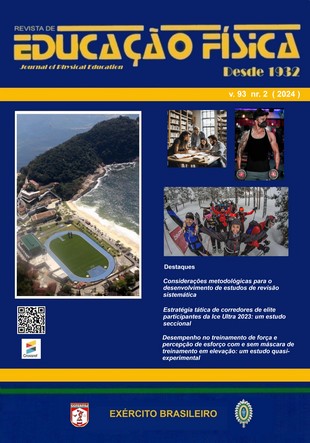Abstract
Introduction: Rhythm strategies in running competitions have been studied at different distances and different routes and reliefs. However, the application of these strategies in ultramarathons, especially in extreme weather conditions, remains poorly understood.
Objective: To investigate the running strategies of ultramarathoners in competitions held under extreme cold and snowy weather conditions.
Methods: Observational, cross-sectional, secondary data study with the participation of 31 Ice Ultra 2023 athletes who covered approximately 225 km over five consecutive days, facing stages of different distances. The data collected included demographic information, race time, pace and speed of the runners. Based on performance, participants were divided into three groups (Top 3, Top 10, and Top 20).
Results: 70.9% finished the race, with an average completion time of 40:39±9:38h:min. A progressive running strategy was observed throughout the days of competition, a negative pace profile during the second stage. The top three finishers were faster in all stages when compared to the top 10 and top 20 (p<0.0001). There was a significant decrease in speed between stages 1 and 2 (Δ Top 3: 2.23±0.14km/h; Δ Top10: 2.11±0.15km/h; Δ Top20: 1.19±0.18km/h) related to geographical relief.
Conclusion: The most successful runners are able to adjust their pace more effectively according to the demands of each stage of the race, adapting better regardless of extreme cold conditions.
References
Scheer V, Krabak BJ. Musculoskeletal Injuries in Ultra-Endurance Running: A Scoping Review. Frontiers in Physiology. 2021;12: 664071. https://doi.org/10.3389/fphys.2021.664071.
Waśkiewicz Z, Nikolaidis P, Chalabaev A, Rosemann T, Knechtle B. Motivation in ultra-marathon runners. Psychology Research and Behavior Management. 2018;Volume 12: 31–37. https://doi.org/10.2147/PRBM.S189061.
Knechtle B, Chlíbková D, Papadopoulou S, Mantzorou M, Rosemann T, Nikolaidis PT. Exercise-Associated Hyponatremia in Endurance and Ultra-Endurance Performance–Aspects of Sex, Race Location, Ambient Temperature, Sports Discipline, and Length of Performance: A Narrative Review. Medicina. 2019;55(9): 537. https://doi.org/10.3390/medicina55090537.
Fernandes AL. Estratégia de estimulação: mecanismo regulatório, influência de fatores ambientais e ritmos circadianos. ACTA Brasileira do Movimento Humano. 2015;5(2): 114–138. http://www.periodicos.ulbra.br/index.php/actabrasileira/article/view/2847
Casado A, Hanley B, Jiménez-Reyes P, Renfree A. Pacing profiles and tactical behaviors of elite runners. Journal of Sport and Health Science. 2021;10(5): 537–549. https://doi.org/10.1016/j.jshs.2020.06.011.
García‐Manso JM, Martínez‐Patiño MJ, De La Paz Arencibia L, Valverde‐Esteve T. Tactical behavior of high‐level male marathon runners. Scandinavian Journal of Medicine & Science in Sports. 2021;31(3): 521–528. https://doi.org/10.1111/sms.13873.
Knechtle B, Rosemann T, Zingg M, Stiefel M, Rüst C. Pacing strategy in male elite and age group 100 km ultra-marathoners. Open Access Journal of Sports Medicine. 2015; 71. https://doi.org/10.2147/OAJSM.S79568.
Hoffman MD. Pacing by Winners of a 161-km Mountain Ultramarathon. International Journal of Sports Physiology and Performance. 2014;9(6): 1054–1056. https://doi.org/10.1123/ijspp.2013-0556.
Costa RJS, Knechtle B, Tarnopolsky M, Hoffman MD. Nutrition for Ultramarathon Running: Trail, Track, and Road. International Journal of Sport Nutrition and Exercise Metabolism. 2019;29(2): 130–140. https://doi.org/10.1123/ijsnem.2018-0255.
Bouscaren N, Millet GY, Racinais S. Heat Stress Challenges in Marathon vs. Ultra-Endurance Running. Frontiers in Sports and Active Living. 2019;1: 59. https://doi.org/10.3389/fspor.2019.00059.
Leon LR, Bouchama A. Heat Stroke. In: Prakash YS (ed.) Comprehensive Physiology. 1st ed. Wiley; 2015. p. 611–647. https://doi.org/10.1002/cphy.c140017. [Accessed 24th September 2024].
Krabak BJ, Waite B, Schiff MA. Study of Injury and Illness Rates in Multiday Ultramarathon Runners. Medicine & Science in Sports & Exercise. 2011;43(12): 2314–2320. https://doi.org/10.1249/MSS.0b013e318221bfe3.
McGowan V, Hoffman MD. Characterization of Medical Care at the 161-km Western States Endurance Run. Wilderness & Environmental Medicine. 2015;26(1): 29–35. https://doi.org/10.1016/j.wem.2014.06.015.
Hall J. Ice Ultra 2023 | Final Results. Beyond the Ultimate. 2023. https://www.beyondtheultimate.co.uk/ice-ultra-2023-stage-five/ [Accessed 24th September 2024].
Shorten MR. The energetics of running and running shoes. Journal of Biomechanics. 1993;26: 41–51. https://doi.org/10.1016/0021-9290(93)90078-S.
Ebben WP, Davies JA, Clewien RW. Effect of the Degree of Hill Slope on Acute Downhill Running Velocity and Acceleration. Journal of Strength and Conditioning Research. 2008;22(3): 898–902. https://doi.org/10.1519/JSC.0b013e31816a4149.
De Souza RF, Santos MMS, Thuany M, Dos Santos Silva D, De Jesus Alves MD, Oliveira DPM, et al. Ultramarathon Evaluation above 180 km in relation to Peak Age and Performance. Masanovic B (ed.) BioMed Research International. 2022;2022: 1–9. https://doi.org/10.1155/2022/1036775.
Scheer V. Participation Trends of Ultra Endurance Events. Sports Medicine and Arthroscopy Review. 2019;27(1): 3–7. https://doi.org/10.1097/JSA.0000000000000198.
Knechtle B, Abou Shoak, Rüst, Lepers R, Rosemann T. European dominance in multistage ultramarathons: an analysis of finisher rate and performance trends from 1992 to 2010. Open Access Journal of Sports Medicine. 2013; 9. https://doi.org/10.2147/OAJSM.S39619.
Damsted C, Parner ET, Sørensen H, Malisoux L, Nielsen RO. ProjectRun21: Do running experience and running pace influence the risk of running injury—A 14-week prospective cohort study. Journal of Science and Medicine in Sport. 2019;22(3): 281–287. https://doi.org/10.1016/j.jsams.2018.08.014.
Périard JD, Eijsvogels TMH, Daanen HAM. Exercise under heat stress: thermoregulation, hydration, performance implications, and mitigation strategies. Physiological Reviews. 2021;101(4): 1873–1979. https://doi.org/10.1152/physrev.00038.2020.
Jeukendrup AE. Nutrition for endurance sports: Marathon, triathlon, and road cycling. Journal of Sports Sciences. 2011;29(sup1): S91–S99. https://doi.org/10.1080/02640414.2011.610348.
Cuk I, Markovic S, Weiss K, Knechtle B. Running Variability in Marathon—Evaluation of the Pacing Variables. Medicina. 2024;60(2): 218. https://doi.org/10.3390/medicina60020218.
Bianchi D, Miller DJ, Lastella M. Sleep–Wake Behaviour of 200-Mile Ultra-Marathon Competitors: A Case Study. International Journal of Environmental Research and Public Health. 2022;19(5): 3006. https://doi.org/10.3390/ijerph19053006.
Haney T, Mercer J. A Description of Variability of Pacing in Marathon Distance Running. International Journal of Exercise Science. 2011;4(2): 133–140. https://doi.org/10.70252/RHGB2099.
Jones AM, Kirby BS, Clark IE, Rice HM, Fulkerson E, Wylie LJ, et al. Physiological demands of running at 2-hour marathon race pace. Journal of Applied Physiology (Bethesda, Md.: 1985). 2021;130(2): 369–379. https://doi.org/10.1152/japplphysiol.00647.2020.
Pycke JR, Billat V. Marathon Performance Depends on Pacing Oscillations between Non Symmetric Extreme Values. International Journal of Environmental Research and Public Health. 2022;19(4): 2463. https://doi.org/10.3390/ijerph19042463.

This work is licensed under a Creative Commons Attribution 4.0 International License.
Copyright (c) 2024 Journal of Physical Education
